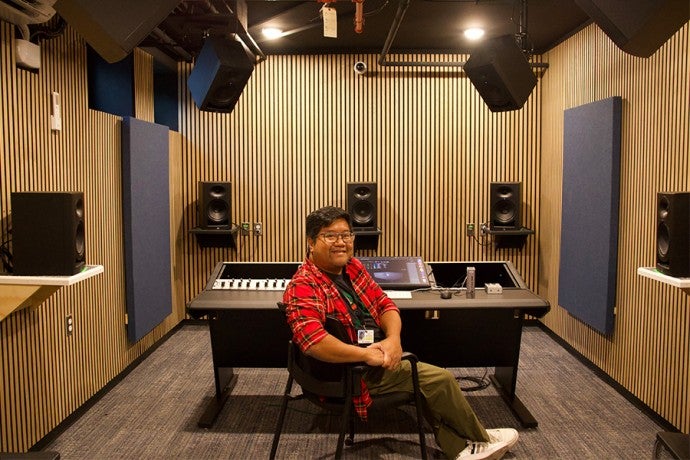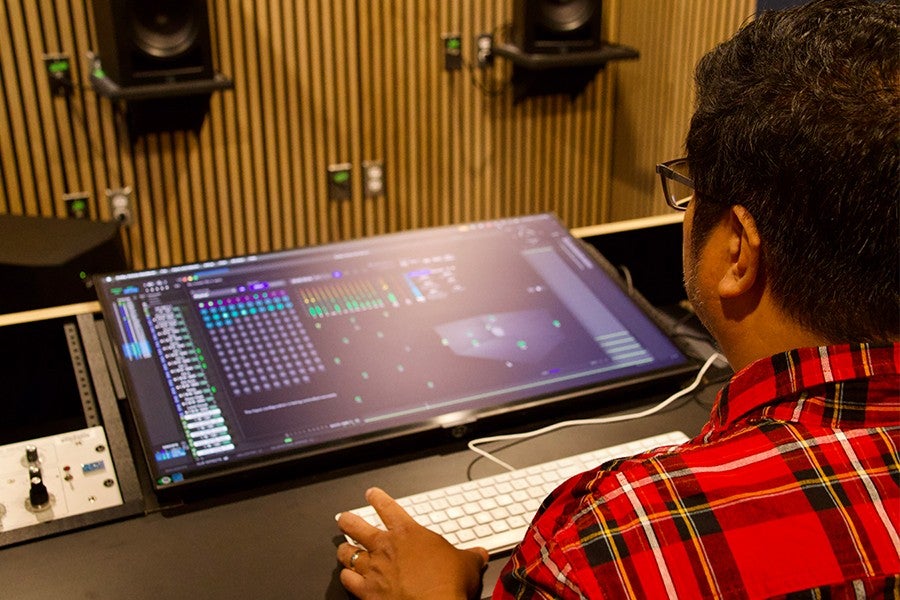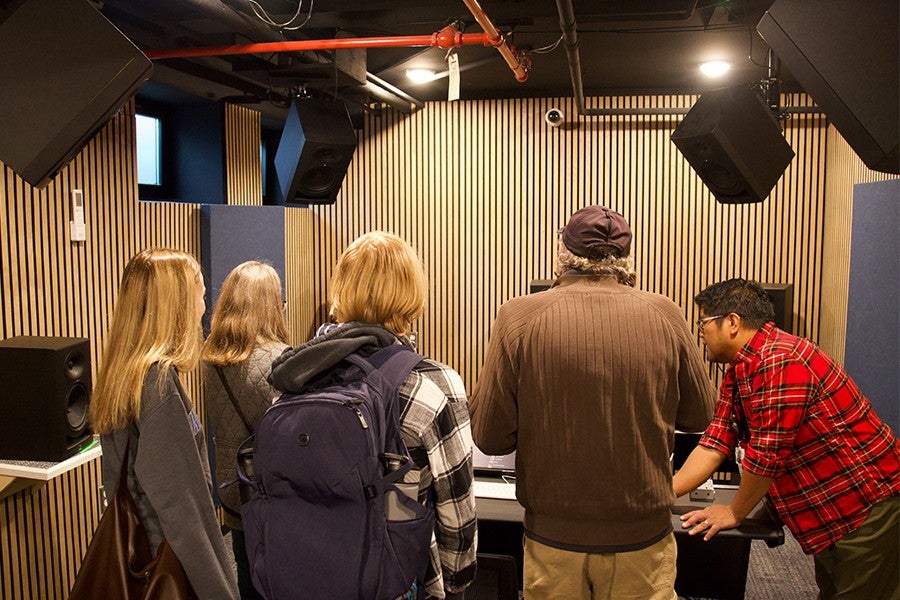Bringing Atmos to Interlochen: Music Production & Engineering program unveils new Dolby Atmos room
Director of Music Production & Engineering Marc Lacuesta explains what Atmos is and why it’s important for students to have access to this immersive audio technology.

Director of Music Production & Engineering Marc Lacuesta sits at the interface in Interlochen’s new Dolby Atmos room.
This fall, Interlochen Arts Academy’s Music Production & Engineering program is unveiling a new studio: A room equipped with Dolby Atmos.
The new space is the culmination of a yearlong collaboration between the Music Production & Engineering faculty, Interlochen’s maintenance team, and several prominent audio engineers to convert a room in the lower level of the Mozart-Beethoven residence hall into an Atmos studio. It’s only the fifth Atmos room in the state of Michigan—and the only one outside the metro Detroit area. Interlochen Director of Music Production & Engineering Marc Lacuesta also believes Interlochen is the only high school that has its own dedicated Atmos room.
Lacuesta was inspired to bring Atmos to Interlochen so that students could gain familiarity with the system.
“We don’t want our students to be surprised by anything, and because Atmos is growing so quickly, we thought we should have a room,” Lacuesta says. “We don’t want our students to go to college and hear about Atmos for the first time. We want them to have experienced it. We want them sitting in the speakers, knowing what it sounds like, and knowing the rudiments of it.”
An immersive audio experience
First launched in 2012, Dolby Atmos is an immersive audio experience. Lacuesta describes it as “what surround sound wanted to be.”
“In surround sound, there are speakers all around you, to the sides and to the back of you,” Lacuesta says. “But in Atmos, the element of height has been introduced: There are also speakers above you. Now, you can put any sound at any height that you’d like, or at any space in the room. I could point to a spot, and I could put a sound at the very tip of my finger.”
Although Atmos was originally designed for use in commercial—and later, home—movie theatres, it’s gaining traction in the music industry.
“Atmos was created for movies, but in the last five or ten years, it has increasingly been used for music,” Lacuesta says. “In fact, major labels will not take your submissions unless they come with an Atmos mix. Now, you not only have to mix in stereo, you also have to mix in Atmos.”
Building Interlochen’s Atmos room
Thanks to the support of generous parent donors, the Music Production & Engineering program was able to begin work on the Atmos studio last year.
“We’re very proud of the fact that we could build this room through the generosity of our parents with zero pressure to the general Music Department budget,” Lacuesta says. “In order to keep costs down, we established a relationship with Kali Audio, which provided us with all our speakers at a discount. I also have an endorsement with Antelope Audio, which I used to buy our hardware and interfaces at a discount.”
Interlochen’s maintenance and grounds crew renovated a space in the lower level of the Mozart-Beethoven residence hall to house the Atmos studio. The room is equipped with 12 speakers—seven satellite speakers, one subwoofer, and four height speakers—all of which are precisely placed within a tolerance of just one centimeter. The room also includes an interface designed to work with the Atmos system.
In August, Lacuesta and his colleagues worked with Todd Burke—an accomplished sound engineer and a member of the Antelope Audio team—to ensure that the room was tuned correctly. Will Kennedy, one of the world’s premier Atmos mixers, also assisted with the project.
“[Kennedy] is an expert, but he’s also one of my best friends from college,” Lacuesta says. “It was very fortuitous that we could get him to come here and help us. He still helps me with the room, even now.”
Sharing Atmos with the community
While there are still a few finishing touches to put on the Atmos studio, Lacuesta is looking forward to welcoming Interlochen’s students, faculty, and staff to the new space.
All Music Production & Engineering students will have the opportunity to experience the room and learn the basics of mixing in Atmos. More advanced study will be reserved for the program’s senior capstone course, which is open to seniors who have attended Interlochen Arts Academy for at least three years.
“I know there are a lot of people who are interested in learning to mix in Atmos, but in order to learn how to mix in Atmos, we need to have you here for three or four years to make sure you’re solid on all the basics,” Lacuesta says. “Mixing in stereo—with two speakers—is hard enough. Now, we’re going to teach you how to mix with 12 speakers. It’s such a departure from regular mixing that we have to make sure that you are solid on all the basics before we teach you Atmos.”
Music Production & Engineering students aren’t the only ones who will get to hear the Atmos room: Lacuesta plans to host an open house sometime soon. But first, he wants to hold a private event for the Interlochen maintenance team members who worked on the room.
“I want them to experience the fruits of their labor first,” he says.
Lacuesta is excited to introduce the Interlochen community to an awe-inspiring new way to listen to music.
“Atmos is really something that’s completely different from stereo,” Lacuesta says. “Many times, when people hear it for the first time, they turn back to me with their mouth open. Sometimes there are tears. Sometimes there’s screaming. A lot of people will say, ‘Now you’ve spoiled me. I don’t want to listen to music any other way.’”







